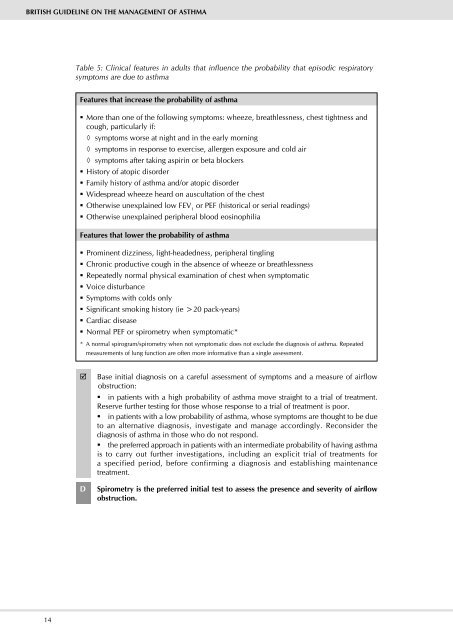sign101
sign101
sign101
Create successful ePaper yourself
Turn your PDF publications into a flip-book with our unique Google optimized e-Paper software.
British Guideline on the MAnAGeMent of AsthMA<br />
14<br />
Table 5: Clinical features in adults that influence the probability that episodic respiratory<br />
symptoms are due to asthma<br />
features that increase the probability of asthma<br />
More than one of the following symptoms: wheeze, breathlessness, chest tightness and<br />
cough, particularly if:<br />
◊ symptoms worse at night and in the early morning<br />
◊ symptoms in response to exercise, allergen exposure and cold air<br />
◊ symptoms after taking aspirin or beta blockers<br />
History of atopic disorder<br />
Family history of asthma and/or atopic disorder<br />
Widespread wheeze heard on auscultation of the chest<br />
Otherwise unexplained low FEv or PEF (historical or serial readings)<br />
1<br />
Otherwise unexplained peripheral blood eosinophilia<br />
features that lower the probability of asthma<br />
Prominent dizziness, light-headedness, peripheral tingling<br />
Chronic productive cough in the absence of wheeze or breathlessness<br />
Repeatedly normal physical examination of chest when symptomatic<br />
voice disturbance<br />
Symptoms with colds only<br />
Significant smoking history (ie >20 pack-years)<br />
Cardiac disease<br />
Normal PEF or spirometry when symptomatic*<br />
* A normal spirogram/spirometry when not symptomatic does not exclude the diagnosis of asthma. Repeated<br />
measurements of lung function are often more informative than a single assessment.<br />
; Base initial diagnosis on a careful assessment of symptoms and a measure of airflow<br />
obstruction:<br />
in patients with a high probability of asthma move straight to a trial of treatment.<br />
Reserve further testing for those whose response to a trial of treatment is poor.<br />
in patients with a low probability of asthma, whose symptoms are thought to be due<br />
to an alternative diagnosis, investigate and manage accordingly. Reconsider the<br />
diagnosis of asthma in those who do not respond.<br />
the preferred approach in patients with an intermediate probability of having asthma<br />
is to carry out further investigations, including an explicit trial of treatments for<br />
a specified period, before confirming a diagnosis and establishing maintenance<br />
treatment.<br />
d Spirometry is the preferred initial test to assess the presence and severity of airflow<br />
obstruction.


